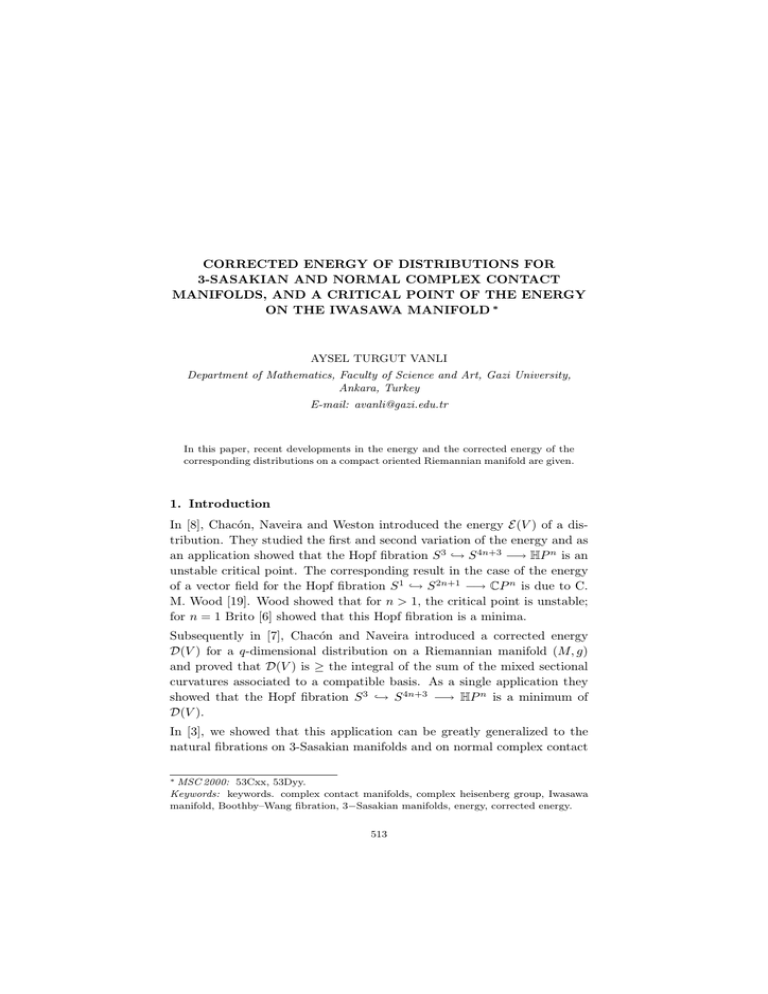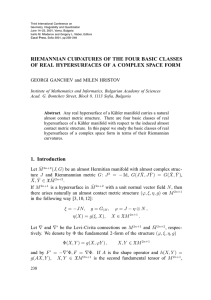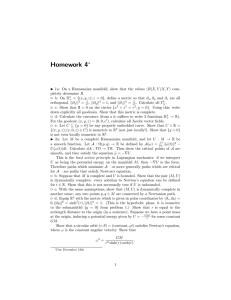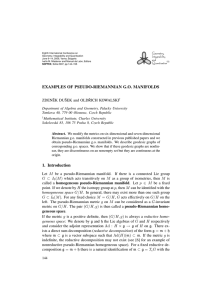CORRECTED ENERGY OF DISTRIBUTIONS FOR 3-SASAKIAN AND NORMAL COMPLEX CONTACT
advertisement

CORRECTED ENERGY OF DISTRIBUTIONS FOR
3-SASAKIAN AND NORMAL COMPLEX CONTACT
MANIFOLDS, AND A CRITICAL POINT OF THE ENERGY
ON THE IWASAWA MANIFOLD ∗
AYSEL TURGUT VANLI
Department of Mathematics, Faculty of Science and Art, Gazi University,
Ankara, Turkey
E-mail: avanli@gazi.edu.tr
In this paper, recent developments in the energy and the corrected energy of the
corresponding distributions on a compact oriented Riemannian manifold are given.
1. Introduction
In [8], Chacón, Naveira and Weston introduced the energy E(V ) of a distribution. They studied the first and second variation of the energy and as
an application showed that the Hopf fibration S 3 ,→ S 4n+3 −→ HP n is an
unstable critical point. The corresponding result in the case of the energy
of a vector field for the Hopf fibration S 1 ,→ S 2n+1 −→ CP n is due to C.
M. Wood [19]. Wood showed that for n > 1, the critical point is unstable;
for n = 1 Brito [6] showed that this Hopf fibration is a minima.
Subsequently in [7], Chacón and Naveira introduced a corrected energy
D(V ) for a q-dimensional distribution on a Riemannian manifold (M, g)
and proved that D(V ) is ≥ the integral of the sum of the mixed sectional
curvatures associated to a compatible basis. As a single application they
showed that the Hopf fibration S 3 ,→ S 4n+3 −→ HP n is a minimum of
D(V ).
In [3], we showed that this application can be greatly generalized to the
natural fibrations on 3-Sasakian manifolds and on normal complex contact
∗
MSC 2000: 53Cxx, 53Dyy.
Keywords: keywords. complex contact manifolds, complex heisenberg group, Iwasawa
manifold, Boothby–Wang fibration, 3−Sasakian manifolds, energy, corrected energy.
513
514
metric manifolds.In [18], we considered as a further application of the results
of [8], the Boothby-Wang fibration of the Iwasawa manifold S 1 × S 1 ,→
H C /Γ −→ C3 /Γ. Making use of the complex contact structure on HC /Γ
we showed that this fibration is also unstable for the energy.
In [11], Gil-Medrano, González-Dávila and Vanhecke studied conditions under which the energy of a distribution, viewed as a map into the Grassmann
bundle, is a harmonic map or minimal immersion.
2. Geometry of Distributions
Let (M n , g) be a compact oriented Riemannian manifold with a qdimensional distribution or subbundle V and let H denote the orthogonal complementary distribution of dimension p = n − q. Let {e1 , . . . , en }
be a local orthonormal basis on M n such that {e1 , . . . , ep } span H and
{ep+1 , . . . , en } span V and adopt the index conventions: 1 ≤ a, b ≤ n,
1 ≤ i, j ≤ p, p + 1 ≤ α, β ≤ n. The second fundamental form of the
horizontal distribution H in the direction eα and that of the vertical distribution V in the direction ei are given respectively by hα
ij = −g(∇ei eα , ej ),
i
hαβ = −g(∇eα ei , eβ ). The mean curvature vectors of the horizontal and
vertical distributions are given respectively by
~H =
H
p
n
³1 X
´
X
hα
eα ,
p i=1 ii
α=p+1
~V =
H
p ³
n
X
1 X
i=1
q
´
hiαα ei .
α=p+1
One can regard a distribution, such as V, as a section of the Grassmann
bundle, G(q, M n ), of oriented q-planes in the tangent spaces of M n . The
geometry of this bundle was developed in [8]. We also view V as a map
ξ : M n −→ G(q, M n ) where ξ(x) is a unit q-vector with respect to the
Vq
induced metric on
(M n ), in particular ξ(x) = ep+1 (x) ∧ · · · ∧ en (x). Note
that we have chosen a local orthonormal basis; in [19], the variation of unit
vector fields is through unit vector fields and the variations of distributions
in [8] are through unit q-vectors. The norm of the covariant derivative of ξ
is given in terms of the second fundamental forms of H and V by
X
X
X
2
(hiαβ )2 .
(1)
||∇ea ξ||2 =
(hα
ij ) +
a
i,j,α
i,α,β
The corrected energy of [7] is defined by
Z ³X
´
~ H ||2 + q 2 ||H
~ V ||2 dvol.
D(V ) =
||∇ea ξ||2 + p(p − 2)||H
M
a
515
We now define the energy of a distribution V as in [8] by
Z X
n
n
1
||∇ea ξ||2 dvol + vol(M ).
E(V ) =
2 M a=1
2
Denote by ∇∗ ∇ξ the rough Laplacian
∇∗ ∇ξ =
n
X
(−∇ea ∇ea ξ + ∇∇ea ea ξ).
a=1
The main results of [7] and [8] are summarized as follows
Theorem 2.1 If V is integrable, then
Z X
ciα dvol
D(V ) ≥
M i,α
where ciα is the sectional curvature of the plane section spanned by ei ∈ H
and eα ∈ V.
Theorem 2.2 A distribution V is a critical point of the energy if and only
Vq
if ∇∗ ∇ξ is orthogonal to all tangent vectors of ξ in
(M n ), i.e.,
X
∇∗ ∇ξ = ||∇ξ||2 ξ +
terms of type H ∧ H ∧ V ∧ · · · ∧ V.
If ξst is a variation of a critical point V through oriented distributions with
tangent fields
∂ξst ¯¯
∂ξst ¯¯
V =
and W =
,
¯
¯
∂s (s,t)=(0,0)
∂t (s,t)=(0,0)
then
Z
¡
¢
∂ 2 E(ξst ) ¯¯
=
g(∇∂s ∇∂t ξst |(0,0) , ∇∗ ∇ξ) + g(W, ∇∗ ∇V ) dvol.
¯
∂s ∂t (0,0)
M
3. 3-Sasakian manifolds
By a contact manifold we mean a differentiable manifold M 2n+1 together
with a 1-form η such that η ∧ (dη)n 6= 0. It is well known that given η there
exists a unique vector field ξ, such that dη(ξ, X) = 0 and η(ξ) = 1; ξ is
called the characteristic vector field or Reeb vector field of the contact form
η.
A Riemannian metric g is an associated metric for a contact form η if, first
of all, η(X) = g(X, ξ) and secondly, there exists a field of endomorphisms φ
516
such that φ2 = −I + η ⊗ ξ and dη(X, Y ) = g(X, φY ). We refer to (φ, ξ, η, g)
as a contact metric structure and to M 2n+1 with such a structure as a
contact metric manifold.
An almost contact structure, (φ, ξ, η), consists of a field of endomorphisms
φ, a vector field ξ and a 1-form η such that φ2 = −I +η⊗ξ and η(ξ) = 1 and
an almost contact metric structure includes a Riemannian metric satisfying
the compatibility condition g(φX, φY ) = g(X, Y ) − η(X)η(Y ).
The product M 2n+1 × R carries a natural almost complex structure defined
by
³
d´ ³
d´
J X, f
= φX − f ξ, η(X)
dt
dt
and the underlying almost contact structure is said to be normal if J is
integrable. The normality condition can be expressed as N = 0 where N is
defined by
N (X, Y ) = [φ, φ](X, Y ) + 2dη(X, Y )ξ,
[φ, φ] being the Nijenhuis tensor of φ.
A Sasakian manifold is a normal contact metric manifold. In terms of the
covariant derivative of φ with respect to the Levi-Civita connection, the
Sasakian condition is
(∇X φ)Y = g(X, Y )ξ − η(Y )X.
As is well known, from this it is easily seen that
∇X ξ = −φX
and in turn that ξ is a Killing vector field, i.e. the contact metric structure is
K-contact. It is also well known that on a K-contact manifold the sectional
curvature of all plane sections containing ξ are equal to +1 (see e.g. [2], p.
92).
A manifold admitting three almost contact structures, (φα , ξα , ηα ),
α = 1, 2, 3, satisfying
φγ = φα φβ − ηβ ⊗ ξα = −φβ φα + ηα ⊗ ξβ .
ξγ = φα ξβ = −φβ ξα ,
ηγ = ηα ◦ φβ = −ηβ ◦ φα
is said to have an almost contact 3-structure. Kuo [17] showed that given
such a structure there exists a Riemannian metric g compatible with each
517
of the three almost contact structures giving us an almost contact metric 3structure (φα , ξα , ηα , g). If each of the three structures is Sasakian we have a
3-Sasakian structure. A remarkable result of Kashiwada [15] is that if each
of the three almost contact metric structures (φα , ξα , ηα , g) is a contact
metric structure, then the structure is a 3-Sasakian structure. There are
many 3-Sasakian manifolds aside from the sphere S 4n+3 including several
homogeneous spaces; see e.g. [2] pp. 218-220 or the survey of Boyer and
Galicki [5].
Using ∇X ξα = −φα X one readily obtains on a 3-Sasakian manifold that
[ξα , ξβ ] = 2ξγ . Thus the distribution V determined by the tri-vector
ξ = ξα ∧ ξβ ∧ ξγ is integrable with totally geodesic leaves. The horizontal
distribution H is defined by ηα = 0, α = 1, 2, 3.
One of the main results of [3] is as follows.
Theorem 3.1 The vertical distribution V on a compact 3-Sasakian manifold is a minima of the corrected energy D(V ).
4. Complex contact manifolds
A complex contact manifold is a complex manifold of odd complex dimension 2n+1 together with an open covering {U} by coordinate neighborhoods
such that
(1) On each U, there is a holomorphic 1-form θ with θ ∧ (dθ)n 6= 0.
(2) On U ∩ U 0 6= ∅ there is a non-vanishing holomorphic function f such
that θ0 = f θ.
The complex contact structure determines a non-integrable distribution H
by the equation θ = 0. A complex contact structure is given by a global
1-form if and only if its first Chern class vanishes [4]. On the other hand let
M be a Hermitian manifold with almost complex structure J, Hermitian
metric g and an open covering by coordinate neighborhoods {U}; M is
called a complex almost contact metric manifold if it satisfies the following
two conditions:
(1) In each U there exist 1-forms u and v = u ◦ J, with dual vector
fields U and V = −JU and (1, 1) tensor fields G and H = GJ such
that
H 2 = G2 = −I + u ⊗ U + v ⊗ V, GJ = −JG, GU = 0,
g(X, GY ) = −g(GX, Y ).
518
(2) On U ∩ U 0 6= ∅, we have
u0 = au − bv,
v 0 = bu + av, G0 = aG − bH,
H 0 = bG + aH
where a and b are functions on U ∩ U 0 with a2 + b2 = 1.
Since u and v are dual to the vector fields U and V , we easily see from
the second condition that on U ∩ U 0 , U 0 = aU − bV and V 0 = bU + aV .
Also since a2 + b2 = 1, U 0 ∧ V 0 = U ∧ V . Thus U and V determine a
global vertical distribution V by ξ = U ∧ V which is typically assumed to
be integrable.
A complex contact manifold admits a complex almost contact metric structure for which the local contact form θ is u − iv to within a non-vanishing
complex-valued function multiple and the local tensor fields G and H are
related to du and dv by
du(X, Y ) = g(X, GY )+(σ∧v)(X, Y ), dv(X, Y ) = g(X, HY )−(σ∧u)(X, Y )
where σ(X) = g(∇X U, V ), ∇ being the Levi-Civita connection of g (Ishihara and Konishi [14], Foreman [9]). We refer to a complex contact metric
manifold with a complex almost contact metric structure satisfying these
conditions as a complex contact metric manifold.
Ishihara and Konishi [12], [13] introduced a notion of normality for complex
contact structures. Their notion is the vanishing of the two tensor fields S
and T given by
S(X, Y ) = [G, G](X, Y ) + 2g(X, GY )U − 2g(X, HY )V + 2(v(Y )HX
− v(X)HY ) + σ(GY )HX − σ(GX)HY
+ σ(X)GHY − σ(Y )GHX,
T (X, Y ) = [H, H](X, Y ) − 2g(X, GY )U + 2g(X, HY )V + 2(u(Y )GX
− u(X)GY ) + σ(HX)GY − σ(HY )GX
+ σ(X)GHY − σ(Y )GHX.
However this notion is too strong; among its implications is that the underlying Hermitian manifold (M, g) is Kähler. Thus while indeed one of the
canonical examples of a complex contact manifold, the odd-dimensional
complex projective space, is normal in this sense, the complex Heisenberg
group, is not. In [16] B. Korkmaz generalized the notion of normality and
we adopt her definition here. A complex contact metric structure is said to
be normal if
S(X, Y ) = T (X, Y ) = 0, for every X, Y ∈ H
519
S(U, X) = T (V, X) = 0, for every X.
Even though the definition appears to depend on the special nature of
U and V , it respects the change in overlaps, U ∩ U 0 , and is therefore a
global notion. With this notion of normality both odd-dimensional complex
projective space and the complex Heisenberg group with their standard
complex contact metric structures are normal.
One important consequence of normality for us is that the sectional curvature of a plane section spanned by a vector in V and a vector in H is equal
to +1 (cf. Korkmaz [16]). Another consequence of normality is that
∇X U = −GX + σ(X)V,
∇X V = −HX − σ(X)U.
(2)
Another important result of [3] is the following.
Theorem 4.1 If M is a compact normal complex contact metric manifold,
then the vertical distribution is a minima of the corrected energy, i.e.
Z
D(V ) =
X
ciα dvol.
M i,α
5. Complex Heisenberg group and the Iwasawa manifold
The complex Heisenberg group is the closed subgroup HC of GL(3, C) given
by
1 z2 z3 ¯
¯
HC = 0 1 z1 ¯z1 , z2 , z3 ∈ C ∼
= C3 .
0 0 1
As we have seen, a complex contact manifold admits a complex contact
structure. Here H C ∼
= C3 and θ = 12 (dz3 − z2 dz1 ) is global, so the structure
tensors may be taken globally.With J denoting the standard almost complex structure on C3 , we may give a complex almost contact structure to
H C as follows. Since θ is holomorphic, set θ = u − iv, v = u ◦ J; also set
4 ∂z∂ 3 = U + iV . Then, with respect to the metric g below,
u(X) = g(U, X),
v(X) = g(V, X).
520
Since we will work in real coordinates, G and H are given by
0 0 0 1 00
0 0 1 0 00
0 0 1 0 0 0
0 0 0 −1 0 0
0 −1 0 0 0 0
−1 0 0 0 0 0
G=
.
, H=
−1 0 0 0 0 0
0 1 0 0 0 0
0 0 −y2 x2 0 0
0 0 x2 y2 0 0
0 0 x2 y2 0 0
0 0 y2 −x2 0 0
Moreover relative to the coordinates (x1 , y1 , x2 , y2 , x3 , y3 ) the Hermitian
metric
0
1 + x22 + y22
0
1 + x22 + y22
1
0
0
g=
0
0
4
−x2
y2
−y2
−x2
00
00
10
01
00
00
−x2
y2
0
0
1
0
−y2
−x2
0
.
0
0
1
In addition {e1 , e1∗ , e2 , e2∗ , e3 , e3∗ } is an orthonormal basis where
∂
∂
∂
∂
∂
∂
+ x2
+ y2
), e1∗ = 2(
− y2
+ x2
),
∂x1
∂x3
∂y3
∂y1
∂x3
∂y3
∂
∂
∂
∂
e2 = 2
, e2∗ = 2
, e3 = U = 2
, e3∗ = −V = 2
.
∂x2
∂y2
∂x3
∂y3
e1 = 2(
(3)
For the purpose of computation we give the Levi-Civita connection of g.
For the Lie algebra of the Lie group HC we have
[e1 , e2 ] = −2e3 , [e1 , e2∗ ] = −2e3∗ , [e1∗ , e2 ] = −2e3∗ , [e1∗ , e2∗ ] = 2e3 (4)
and the other Lie brackets are zero.The non-zero covariant derivatives of
the basis elements are the following
∇e2 e3 = ∇e2∗ e3∗ = −e1 ,
∇e2∗ e3 = −∇e2 e3∗ = e1∗ ,
∇e1 e3 = ∇e1∗ e3∗ = e2 ,
∇e1 e3∗ = −∇e1∗ e3 = e2∗ ,
−∇e1 e2 = ∇e1∗ e2∗ = e3 ,
∇e1 e2∗ = ∇e1∗ e2 = −e3∗ .
In [16] (see also [2] p.203) B. Korkmaz computed the covariant derivatives
of G and H as
(∇X G)Y = g(X, Y )U −u(Y )X −g(X, JY )V −v(Y )JX +2v(X)GHY (5)
(∇X H)Y = g(X, Y )V −v(Y )X +g(X, JY )U +u(Y )JX −2u(X)GHY. (6)
521
In [1] and [2] the following are also listed for the complex Heisenberg group
g(∇X U, V ) = 0, ∇X U = −GX, ∇X V = −HX
Now let
(7)
1 γ2 γ3 ¯
¯
Γ = 0 1 γ1 ¯γk = mk + ink , mk , nk ∈ Z ;
0 0 1
∼ C3 and the 1− form dz3 − z2 dz1 is invariant
Γ is a subgroup of HC =
under the action on Γ. Hence the quotient HC /Γ is a compact complex
contact manifold with a global complex contact form. HC /Γ is known as the
Iwasawa manifold and it fibres over a complex torus C2 /Γ with ξ = U ∧ V
giving the vertical distribution V. Moreover the integral submanifolds of V
are tori S 1 × S 1 ; this fibration is known as the Boothby-Wang fibration of
HC /Γ [10]. The Iwasawa manifold has no Kählerian structure, but it does
have an indefinite Kählerian structure and it has symplectic forms.
The main results of [18] are summarized as follows.
Theorem 5.1 The vertical distribution V of the complex contact structure
on the Iwasawa manifold is a critical point of the energy.
Theorem 5.2 The Boothby-Wang fibration S 1 × S 1 ,→ HC /Γ −→ C2 /Γ is
an unstable critic point of the energy.
Acknowledgement
The author would like to express her sincere thanks to professor David E.
Blair for his invaluable suggestions.
References
1. C. Baikoussis, D. E. Blair and F. Gouli-Andreou, Holomorphic Legendre
Curves in the Complex Heisenberg Group, Bull. of the Inst. of Math. Aced.
Sinica, 26, (1988), 179-194.
2. D. E. Blair, Riemannian Geometry of Contact and Symplectic Manifolds, In:
Progress in Mathematics, 203, Birkhäuser, Boston, 2002.
3. D. E. Blair and A. Turgut Vanli, Corrected Energy of Distributions for 3Sasakian and Normal Complex Contact Manifolds, Osaka J. Math. 43 (2006),
193–200.
4. W. M. Boothby, Homogeneous complex contact manifolds, Proc. Symp. Pure
Math. III, Amer. Math. Soc., (1961), 144-154.
522
5. C. P. Boyer and K. Galicki, 3-Sasakian manifolds, In: Essays on Einstein
Manifolds, International Press, Cambridge, MA, (1999), 123-184.
6. F. G. B. Brito, Total bending of flows with mean curvature correction, Diff.
Geom. Appl. 12 (2000), 157-163.
7. P. M. Chacón and A. M. Naveira, Corrected energy of distributions on Riemannian manifolds, Osaka J. Math. 41 (2004), 97-105.
8. P. M. Chacón, A. M. Naveira and J. M. Weston , On the energy of distributions with application to quaternionic Hopf fibrations, Monatsh. Math. 133
(2001), 281-294.
9. B. Foreman, Variational Problems on Complex Contact Manifolds with Applications to Twistor Space Theory, Thesis, Michigan State University, 1996.
10. B. Foreman, Boothby-Wang fibration on complex contact manifolds, Diff. Geo.
and its Appl. 13 (2000), 179-196.
11. O. Gil-Medrano, J. C. Gonzalez-Davila and L.Vanhecke, Harmonicity and
minimality of oriented distributions, Israel J. Math., 143, (2004), 253-279.
12. S. Ishihara and M. Konishi, Real contact 3-structure and complex contact
structure, Southeast Asian Bulletin of Math. 3 (1979), 151-161.
13. S. Ishihara and M. Konishi, Complex almost contact manifolds, Kōdai Math.
J. 3 (1980), 385-396.
14. S. Ishihara and M. Konishi, Complex almost contact structures in a complex
contact manifold, Kōdai Math. J. 5 (1982), 30-37.
15. T. Kashiwada, On a contact 3-structure, Math. Z. 238 (2001), 829-832.
16. B. Korkmaz, Normality of complex contact manifolds, Rocky Mountain J.
Math., 30 (2000), 1343-1380.
17. Y. Y. Kuo, On almost contact 3-structure, Tôhoku Math. J. 22 (1970), 325332.
18. A. Turgut Vanli and D. E. Blair, The Boothby-Wang Fibration of the Iwasawa
Manifold as a Critical Point of the Energy , Monatsh. Math. 147 (2006), 75–
84.
19. C. M. Wood, On the energy of a unit vector field, Geom. Dedicata 64 (1997),
319-330.






